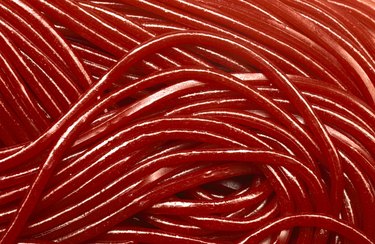
Stool color is a topic you may be hesitant or embarrassed to discuss with your health-care provider. Most people have what they consider to be their normal stool color, but when your elimination looks different from your expectations, you may think that your discolored stool is abnormal and cause for worry. A wide range of factors contributes to discolored stools, including licorice candy.
Black Stools
Video of the Day
Black stools can indicate bleeding in the upper section of the digestive system, mainly the esophagus and stomach. Most often than not, however, black or dark-colored stools can be the result of your diet and lifestyle. Taking iron supplements, smoking and eating foods that are black or dark purple may cause you to eliminate black feces, including grape juice, dark chocolate cookies and black licorice. Black stools that are diet-related are not a cause for concern. Speak with your doctor if you have not been eating licorice or other similarly colored foods to determine the cause of your problem.
Video of the Day
Red Stools
From time to time, you may notice your stools contain bright red matter. Medical reasons for the discoloration include bleeding from the lower digestive tract, including rectal bleeding from hemorrhoids. Bleeding anywhere in your digestive tract can be alarming and merits a trip to your physician. Bright red discoloration of the stool can also be induced through dietary means. Red licorice twists are among the foods that can cause this brightness in the bowl.
Green Stools
Green stools are often the result of having large amounts of unprocessed bile in your digestive tract. Bile breaks down during digestion, but if you experience diarrhea, food moves through your system so quickly that the bile does not have time to break down. Most types of licorice candy are not really made with the herb licorice but rather with anise oil, and the candy is predominantly sugar. Eating too much sugar or having a sensitivity to anise oil may cause gastrointestinal discomfort and diarrhea, which could give you green stools.
Digestive Time Frame
Understanding the basics of digestion can help you determine if licorice is a factor in your unusual stool color. The food you eat stays in your upper digestive tract for up to eight hours after you have eaten, before moving to the large intestine. Once in the large intestine, also called the colon, nutrients are absorbed from the partially digested food, and the undigested matter absorbs water. In most cases, you do not begin to eliminate until at least 24 hours after eating. Complete elimination of any given item you have consumed may take up to three days. If you are worried about your stool color, keep track of when you ate licorice and check your stool color in the next few days to determine if the candy is the culprit.
- The Children's Hospital; Stools -- Unusual Color; Barton D. Schmitt; October 2010
- MayoClinic.com; Stool Color: When to Worry; Michael Picco; May 2010
- Medline Plus: Blood or Tarry Stools; Jacob L. Heller; January 2011
- MayoClinic.com; Digestion: How Long Does It Take?; Michael Picco; August 2010
- Medline Plus; Licorice; April 2011